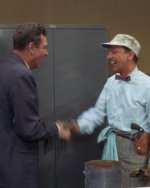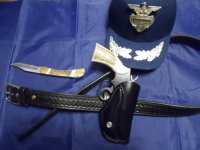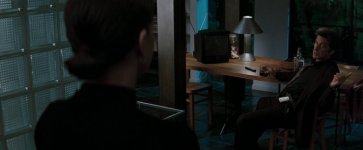A little semi-official "I was there when..." history for you.
I spent my career with Denver Police in Colorado, and used a crossdraw in uniform for a few years. They issued the same or similar holster that the Colorado State Patrol issued, made by a local saddle company among other suppliers. Around half of the officers used those, mostly the really old guys, but we could use any plain black duty holster we wanted. One of the things that some cops used to do was have a leather person (holster-maker or cobbler) re-sew the belt loop to tilt the holster to around 45 degrees. I made some of my own holsters, and liked to make mine darn-near horizontal. Since I did my own leather work, word got around and I fixed quite a few holsters for the guys.
No one ever was concerned about gun-snatches, and although you might think otherwise, I do not recall a single one. One reason was that the gun butt was a convenient hand rest. Everyone I knew developed the same habit of leaning or holding that butt whenever around people. The crossdraw couldn't be grabbed from the back, and was exceptionally easy to draw when seated in a car, something we did whenever anyone came up to us, especially around housing projects.
When semi-autos were introduced in 1989, we weren't allowed to carry them in crossdraws for duty, and the practice started dying out. They completely outlawed them about 10 or so years later for all duty use.
I was told by trooper friends that the reason Colorado State Patrol wore crossdraws was because their chiefs wanted them. And since CSP was one of those "everyone wears exactly the same leather gear in exactly the same place" departments, that's just how it was.
I was told years ago what one of the previous posts mentioned, that the reason crossdraw was so popular with plainclothesmen (now there's a 1930's term!) was that they'd use their left hand to open their suit coat and reach in with the right. I also recall reading someplace that when the FBI taught drawing a gun from the strong side, they were supposed to make some sort of "quick-step" to the left, and that was supposed to make the suit coat catch air and open up enough to reach in. That always sounded kinda hokey to me, but then we are talking about the feds.
I remember quite a few of the dicks, especially the narcs, using that "cavalry-style" draw back in the old days. Some did it "Mexican" style with no holster. Cops back then, at least in the city, were notorious copy-cats, so when us youngsters saw those cooler-than-cool narcs carrying that way, you can bet a lot of us (including yours truly) tried it, too. I found it to be better suited to semi-autos, only because they were easier to hide that way than a revolver.
Nowadays, I find myself going back to crossdraw. Reverse shoulder replacement has limited my backward arm motion, so drawing from a strong-side high ride of any kind is uncomfortable if not impossible.
By the way: S&W Fan, I started with Denver in 1979, so we may have crossed paths back then.




